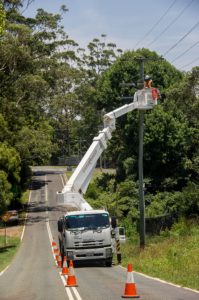
Despite a creative argument from an employer, the Eleventh Circuit has found that employees are required to tie-off for fall protection when they are in an aerial lift. Empire Roofing Co. v. Occupational Safety and Health Review Comm., No. 16-17309, 2017 WL 4708162 (11th Cir. Oct. 19, 2017). In April 2013, an OSHA compliance officer inspected a work site where Empire Roofing was installing metal sheeting on the roof. The officer saw Empire’s foreman standing in the basket of an aerial lift without being tied off to the boom or basket. The foreman later admitted that he previously used the aerial lift to transport two employees to the roof. OSHA fined Empire Roofing for a violation of the OSHA act, and Empire Roofing challenged that fine.
An OSHA regulation required that “[a] body belt shall be worn and a lanyard attached to the boom or basket when working from an aerial lift.” 29 C.F.R. § 1926.453(b)(2)(v). Despite the fairly clear language of that regulation, Empire Roofing argued that its employees were not actually “working” from the lift. Instead, they were merely “riding” in the lift. Nevertheless, OSHA’s established interpretation of the term “working” found “[i]t is well established that employees are considered to be working any time they are performing work or work-related activities. Moving from one work location to another is considered work-related activity.” The Eleventh Circuit found that OSHA’s interpretation of that regulation was reasonable, and therefore deferred to OSHA.
Empire Roofing also tried to claim that it could not be responsible for the foreman’s “rogue conduct” in allowing the employees to ride in the aerial lift without tying off. The Eleventh Circuit found that Empire Roofing would not have been liable if the foreman was the sole person riding in the lift without tying off. But, because Empire Roofing gave the foreman control over other employees, and the foreman exposed those employees to danger, Empire Roofing was liable for transporting those employees in violation of the regulation.